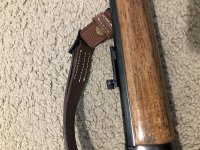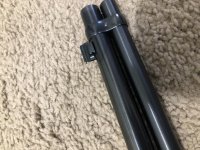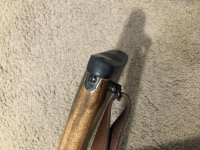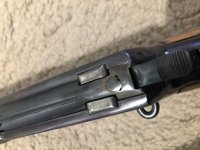Skinner makes a barrel mount peep sight that fits 3/8” dovetails. I have found it to really clean up the sight picture.
Way back in the day I used a very vintage - even at the time (late 1980s) 1903A1 Springfield to shoot a service rifle match, just for fun and as something different from my M1A. I couldn’t get points for the match anyway so there was no downside.
U
The 1903A1 used a barrel mounted sight that served as a battle sight when folded down and as an adjustable sight when erected, with a U notch at the top but also a peep sight below it.
Back in the 1930s they had a micrometer device that let you precisely adjust the sight for National Match shooting. 50 years later it still worked as well as it ever did, but…it also made it very clear to me how much better a receiver mounted peep sight was for a number of reasons, even with 23 year old eyes.
1) A receiver sight is close enough to your eye that your eye naturally centers the front sight in the center of the rear aperture.
2) A receiver sight serves an an aperture just like a camera aperture and increases the depth of field of your eye. That means you are able to see things in sharp or at least sharper focus over a much broader range of distance. That can improve the target image while focusing on the front sight. As you age you’ll find it also allows you to focus on the front sight without glasses.
3) Many receiver sights also allow you to use an adjustable aperture or install different sized apertures. That lets you adjust the amount of light going through the aperture to optimize the depth of field effects without dimming the image in lower light. A large aperture or ghost ring aperture is also ideal for short range and snap shooting and shooting at fast moving targets.
A tang sight is mounted a bit farther back and increases all of the above benefits over a receiver sight. That’s particularly true with exposed hammer fired lever guns as the receiver sight is often farther forward than it is on many other designs.
THIS IS A 60,000 psi action. You can really go ham on the ammo they will eat.
The Rossi 92 is a product improved version of the Winchester 1892. Rossi was making their version of the 1892 in modern magnum pistol rounds for over 40 years before Winchester got back in the 1892 game again with modern magnum pistol cartridges.
However, the Winchester Model 1892 was already a very strong action as it was just a downsized 1886 action. With the exception of the 1885 High Wall, the 1892 was the strongest action Winchester ever made prior to the Model 54 bolt action rifle.
For a M92 60,000 psi is conservative, especially with the small .357 case head diameters. Rossi chambered its Model 92 in the .454 Casull for a few years and it’s a 65,000 psi cartridge, even though most factory loads run a round 55,000 psi. Rossi also made a limited production run of Model 92s in .480 Ruger which is a 48,000 psi round, but with a larger case head diameter and area (and thus greater bolt thrust) as well as thinner chamber walls in the M92 compared to the .454 Casull.
Both of those Model 92s used a magazine tube that threaded into the receiver due to the particularly stout recoil. Even with a rubber butt pad recoil was fierce with the .454 Casull and sales were not worth the different manufacturing steps and parts required and Rossi discontinued it in 2015. Interestingly, Rossi brought it back recently in the 20” carbine model, so we’ll see how it sells.
——
However, the limiting factor pressure wise is often the brass. For example, you can load .45 Colt to 50,000 psi in a M92, but brass life is exceedingly short as the the tapered chamber dimensions work the brass excessively and you get spider cracks in the sidewalls. I load my .45 Colt M92 ammo down around 32,000 psi and if I need more performance I’ll buy a M92 in .454 Casull.








